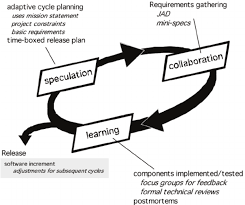Software development is a process that involves designing, coding, testing, and maintaining software applications. It is a complex and ever-evolving field that requires a high level of skill and expertise. Software development can be used for a wide range of applications, from creating mobile apps to developing complex business software systems.
One of the key aspects of software development is the design phase. During this phase, developers work closely with clients to understand their needs and requirements. This involves identifying the features that are required for the application, as well as any constraints or limitations that need to be taken into consideration.
Once the design phase is complete, developers move on to the coding phase. This involves writing code in various programming languages such as Java, Python, or C++. The coding phase is where developers bring the design to life by creating the functionality of the application.
After coding is complete, testing begins. This involves testing the application for bugs and errors to ensure that it works as intended. Testing is an important part of software development because it ensures that the application functions correctly and meets all client requirements.
Finally, once testing is complete and any bugs have been fixed, maintenance begins. Maintenance involves making updates to the software over time to keep it up-to-date with changing technology trends or user requirements.
In today’s world where technology plays such a significant role in our lives, software development has become an essential part of many businesses’ operations. From small startups to large corporations, every company needs software applications in order to run efficiently and effectively.
In conclusion, software development is a complex process that requires a high level of skill and expertise. It involves designing, coding, testing, and maintaining software applications for various purposes such as mobile apps or business systems. As technology continues to evolve at a rapid pace, software development will remain an essential field for businesses around the world.
9 Essential Tips for Successful Software Development
- Research the latest technologies and trends in software development to stay up-to-date.
- Document your code so that it is easier to maintain and understand by others.
- Test your code thoroughly to ensure accuracy and reliability.
- Follow coding best practices such as using descriptive variable names, avoiding hard-coded values, etc.
- Use version control systems such as Git or Subversion to track changes in your codebase over time.
- Automate repetitive tasks whenever possible so you can save time and effort in the long run.
- Use a bug tracking system to keep track of any issues that may arise during development or testing phases of the project lifecycle.
- Take regular breaks while coding – this will help you stay focused and productive for longer periods of time!
- Collaborate with other developers on projects when possible; this can help increase productivity and creativity throughout the entire development process
Research the latest technologies and trends in software development to stay up-to-date.
In the world of software development, it’s important to stay up-to-date with the latest technologies and trends. With technology evolving rapidly, it’s easy to fall behind and miss out on new opportunities. That’s why researching the latest technologies and trends in software development is crucial for any developer or business that wants to stay ahead of the curve.
Keeping up with the latest technologies and trends can help developers create better applications that are more efficient, effective, and user-friendly. It also allows businesses to remain competitive by offering cutting-edge software solutions that meet the needs of their customers.
One way to stay up-to-date is by attending conferences, workshops, and other events that focus on software development. These events provide an opportunity to learn about new technologies and trends from experts in the field. They also offer a chance to network with other developers and businesses in the industry.
Another way to stay informed is by reading industry publications, blogs, and forums. These resources provide valuable insights into emerging technologies and trends, as well as best practices for software development.
Overall, staying up-to-date with the latest technologies and trends in software development is essential for success in today’s fast-paced digital landscape. By investing time in research and education, developers can create better applications that meet the needs of their clients while keeping pace with changing technology trends.
Document your code so that it is easier to maintain and understand by others.
Documenting your code is an essential part of software development that can make it easier for others to understand and maintain your code. When you document your code, you create a record of how the code works, what it does, and why it was created. This can be incredibly helpful for other developers who may need to work on the same code in the future or for yourself if you need to revisit the code later on.
Documenting your code can take many forms, from adding comments within the code itself to creating separate documentation files. Comments are short notes that explain what each section of the code does, while documentation files provide a more detailed overview of how the entire application works.
By documenting your code, you make it easier for others to understand how it works and why certain decisions were made during its development. This can save time and reduce errors when changes need to be made to the code in the future.
In addition, documenting your code can also help you maintain a clear understanding of how everything fits together. It can be easy to forget certain details about how a particular piece of software works over time, but good documentation ensures that important information is always available when needed.
In conclusion, documenting your code is an essential part of software development that should not be overlooked. By taking the time to document your work properly, you make it easier for others to understand and maintain your code in the future. This helps ensure that your software continues to function effectively over time and reduces errors caused by misunderstandings or confusion about how things work.
Test your code thoroughly to ensure accuracy and reliability.
Testing your code thoroughly is one of the most important steps in software development. It ensures that your code is accurate, reliable, and free from bugs or errors. Testing your code involves running a series of tests to identify any issues that may arise during the application’s use.
There are different types of testing that can be performed, including unit testing, integration testing, and system testing. Unit testing involves testing individual pieces of code to ensure they work as intended. Integration testing involves combining different units of code to test how they interact with each other. System testing involves testing the entire application to ensure it works as a whole.
Thoroughly tested code is essential for ensuring that your application functions correctly and meets all client requirements. It also helps to prevent issues from arising in the future and saves time and resources in the long run.
In addition to ensuring accuracy and reliability, thorough testing also helps improve the overall quality of your software development project. By identifying and fixing any errors early on in the development process, you can ensure that your application is delivered on time and within budget.
In conclusion, testing your code thoroughly is an essential step in software development. It ensures accuracy, reliability, and helps improve the overall quality of your project. By taking the time to test your code thoroughly, you can avoid issues down the line and deliver a high-quality product to your clients or users.
Follow coding best practices such as using descriptive variable names, avoiding hard-coded values, etc.
When it comes to software development, following coding best practices is essential for creating clean, efficient, and maintainable code. One of the most important best practices is using descriptive variable names. This means that variable names should accurately describe what they represent in the code. For example, instead of using a vague variable name like “x”, use a more descriptive name like “numberOfUsers”.
Another important best practice is avoiding hard-coded values. Hard-coded values are values that are directly included in the code rather than being stored as variables. This can make the code difficult to maintain and update in the future. Instead, it’s better to store values as variables so they can be easily changed if needed.
Other coding best practices include following consistent formatting and indentation, commenting code to explain its purpose and functionality, and breaking up large blocks of code into smaller functions or methods.
Following these coding best practices not only makes your code more readable and maintainable but also helps prevent errors and bugs from occurring. It also makes it easier for other developers to understand your code if they need to work on it in the future.
In conclusion, when it comes to software development, following coding best practices such as using descriptive variable names and avoiding hard-coded values is essential for creating clean, efficient, and maintainable code. By following these best practices consistently throughout your development process, you can ensure that your code is easy to read, update, and understand by other developers.
Use version control systems such as Git or Subversion to track changes in your codebase over time.
When it comes to software development, keeping track of changes in your codebase over time is crucial. This is where version control systems such as Git or Subversion come in handy.
Version control systems allow developers to keep track of changes made to the codebase over time. They provide a history of all changes made to the code, including who made the changes and when they were made. This makes it easy for developers to revert back to previous versions of the code if needed, or to identify where a bug was introduced.
Using a version control system also makes it easier for teams of developers to collaborate on projects. It allows multiple people to work on the same codebase simultaneously without worrying about conflicts or overwriting each other’s work.
Git and Subversion are two popular version control systems that are widely used in the software development industry. Git is a distributed version control system that allows developers to work offline and merge changes from multiple sources easily. Subversion is a centralized version control system that provides more fine-grained access controls and permissions.
In conclusion, using version control systems such as Git or Subversion is essential for software development projects. They help developers keep track of changes made to the codebase over time, make it easier for teams to collaborate on projects, and provide an easy way to revert back to previous versions if needed. By incorporating these tools into your workflow, you can ensure that your software development projects run smoothly and efficiently.
Automate repetitive tasks whenever possible so you can save time and effort in the long run.
In software development, there are often many repetitive tasks that need to be completed in order to create a successful application. These tasks can be time-consuming and tedious, but they are essential for ensuring that the application functions correctly. That’s where automation comes in.
Automating repetitive tasks can save developers a significant amount of time and effort in the long run. By automating these tasks, developers can focus on more important aspects of the application, such as coding and testing. This not only saves time but also reduces the risk of errors and improves overall productivity.
There are many tools available for automating repetitive tasks in software development. For example, there are tools that can automatically generate code based on pre-defined templates or specifications. There are also tools that can automate testing processes by running automated tests on the application to identify any bugs or errors.
By automating repetitive tasks, developers can also improve the quality of their work. Automation ensures that each task is completed consistently and accurately every time, reducing the risk of human error. This results in higher-quality code and a more reliable application.
In conclusion, automating repetitive tasks is an essential tip for software development. It saves time and effort in the long run while improving overall productivity and quality of work. Developers should take advantage of the many tools available for automation to ensure that their applications are successful and efficient.
Use a bug tracking system to keep track of any issues that may arise during development or testing phases of the project lifecycle.
When it comes to software development, it’s important to keep track of any issues that may arise during the development or testing phases. One way to do this is by using a bug tracking system. This system allows developers to log and track bugs or issues that they encounter during the development process, making it easier to identify and fix them quickly.
A bug tracking system can help streamline the development process by providing a centralized location for all issues to be tracked. This means that developers can easily see what bugs have been reported, who reported them, and what their current status is. It also helps ensure that no bugs slip through the cracks and go unnoticed, which can save time and resources in the long run.
Using a bug tracking system also provides valuable data for project managers and stakeholders. They can use this information to identify patterns in the types of bugs that are being reported, which can help inform decisions about future projects or updates.
In conclusion, using a bug tracking system is an essential tool for any software development team. It helps ensure that all issues are tracked and addressed in a timely manner, streamlines the development process, and provides valuable data for project managers and stakeholders. By implementing this tip into your software development process, you can improve efficiency and reduce errors in your projects.
Take regular breaks while coding – this will help you stay focused and productive for longer periods of time!
As a software developer, it’s easy to get lost in the code and forget to take breaks. However, taking regular breaks while coding is an important tip that can help you stay focused and productive for longer periods of time.
Coding can be mentally exhausting, and staring at a computer screen for hours on end can lead to eye strain and fatigue. Taking a break every hour or so can help you avoid burnout and keep your mind fresh.
During your breaks, try to step away from your computer and do something that doesn’t involve technology. Take a walk outside, stretch your legs, or grab a healthy snack. These activities will help you clear your mind and recharge your batteries so that you can return to coding with renewed energy.
In addition to helping you stay focused and productive, taking regular breaks can also improve the quality of your code. When you take a break and come back to your work with fresh eyes, you may notice mistakes or areas for improvement that you didn’t see before.
In conclusion, taking regular breaks while coding is an important tip for staying focused and productive. By stepping away from your computer every hour or so, you can avoid burnout, clear your mind, recharge your batteries, and improve the quality of your code. So next time you’re knee-deep in code, remember to take a break!
Collaborate with other developers on projects when possible; this can help increase productivity and creativity throughout the entire development process
Collaboration is an essential aspect of software development. Working with other developers on projects can help increase productivity and creativity throughout the entire development process. Collaborating with others allows for the sharing of ideas, knowledge, and skills, which can lead to better solutions and more efficient workflows.
One of the main benefits of collaboration is increased productivity. When working on a project alone, it’s easy to become stuck or overwhelmed by a problem. However, when working with others, you have access to different perspectives and ideas that can help you overcome obstacles more quickly and efficiently.
Collaboration also fosters creativity. Brainstorming sessions with other developers often lead to innovative solutions that may not have been possible otherwise. When working in a group, developers can build upon each other’s ideas and create something truly unique.
In addition to these benefits, collaboration also helps ensure that projects are completed on time and within budget. By dividing tasks among team members and working together towards a common goal, projects are completed more efficiently than when worked on individually.
Overall, collaborating with other developers on projects is an effective way to increase productivity and creativity throughout the entire software development process. Whether you’re working on a small project or a large-scale enterprise system, collaboration can help ensure its success.




